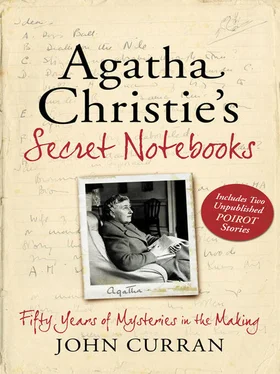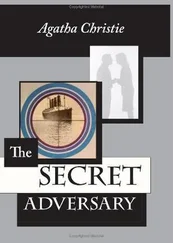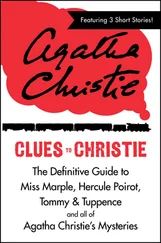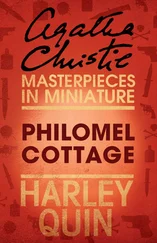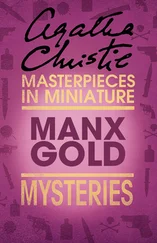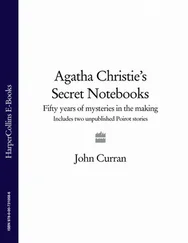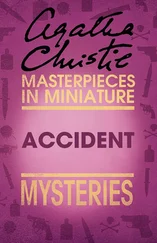Finally, the five questions of Chapter 32 all appear in the Notebook as they appear in the book, apart from a different initial (‘J’) for the Mary Drower question and the substitution of the shorter and subtler ‘Ascot hat’ one for the Franklin Clark.
One of the main themes of Chapter 32 and 35, that of a murderer hunted like a fox, is captured in a last cryptic note:
Bit about the fox
‘Strange Jest’ July 1944
When wealthy Uncle Mathew dies and leaves very little in his will, his legatees approach Miss Marple in an attempt to uncover the whereabouts of his missing fortune.
The Miss Marple short story ‘Strange Jest’ was first published in the USA in November 1941 but did not appear in the UK until almost three years later. It is a slight non-crime story built around a single device, the interpretation of clues to a missing fortune. Its brevity, a mere ten pages, confirms its similarity to a rebus or literary acrostic.
The interpretation of a will appears in a few Christie short stories. Poirot deals with ‘The Case of the Missing Will’, Tommy and Tuppence tackle ‘The Clergyman’s Daughter’/‘The Red House’ and ‘Strange Jest’ is one of the Miss Marple versions, the other being ‘Motive Vs. Opportunity’ in The Thirteen Problems.
A page in Notebook 62 headed ‘Short Marple Stories’ goes on to list ideas that eventually appeared as ‘The Case of the Perfect Maid’, ‘The Case of the Caretaker’, ‘Tape-Measure Murder’, The Moving Finger and, oddly, Endless Night. There are also some unused ideas, including two that appear again and again, the twins and the chambermaid (see ‘The House of Dreams’, page 303). Some pages later, there are three pages of notes on ‘Strange Jest’ including a full outline of the plot:
Found on love letters from abroad—cryptogram in letter? No—stamps on it.
Old Uncle Henry—died—had money but hid it somewhere—Gold? Diamonds? Bonds? Last words—taps his eye—(glass eye like Arsene Lupin). They look through desk—secret drawer found by furniture expert—love letters from Sierra Leone signed Betty Martin
The idea of unrecognised and valuable stamps on an envelope appears again in Spider’s Web nearly 15 years later. The main clue in the story, the phrase ‘all my eye and Betty Martin’, is exactly the same as the main clue in ‘The Four Suspects’ in The Thirteen Problems. The reference to Arsène Lupin is to the crime story ‘The Crystal Stopper’ featuring the French detective, by Maurice Leblanc.
Also of note is the glass eye idea itself. Christie decided not to use it in this story, instead adopting the idea of Uncle Henry (Mathew in the published version) tapping his eye. But it is entirely possible that the glass eye, which formed a key plot device in A Caribbean Mystery, almost 25 years later, has its origins here.
A Murder is Announced 5 June 1950
An advertisement in the local paper announcing a murder brings many of the inhabitants of Chipping Cleghorn to Little Paddocks, the home of Miss Blacklock, where the ensuing game of Murder turns deadly. Miss Marple, who is visiting the local vicar, investigates a triple killing.
A Murder is Announced was Agatha Christie’s fiftieth title (although a 1939 US collection, The Regatta Mystery, had to be included in order to reach this significant number) and the occasion of a major launch and celebration party in London’s Savoy Hotel in June 1950. She happily posed for photographs with Sir William Collins beside a cake iced with the jacket design. Other guests included fellow crime writer Ngaio Marsh and the actress Barbara Mullen, then appearing in the West End as Miss Marple in The Murder at the Vicarage.
A Murder is Announced remains one of the best detective novels Christie ever wrote. It qualifies effortlessly for the Top Ten and it is easily the best of the Marple titles. The last of the ingeniously constructed, daringly clued and perfectly paced detective novels and a wonderful half-century title, it shares a major plot device with both ‘The Companion’ in The Thirteen Problems and ‘The House at Shiraz’ (see Chapter 8) in Parker Pyne Investigates. Although we do not have extensive notes for this title—just ten pages in total—we do have interesting ideas that were toyed with before settling on the final plot. The following reference, in Notebook 35, is idea J in an alphabetical list, dated 1947:
J. A Murder has been (combine with H)
People going to meet in a Country house Or at a dinner party in London Like [Ten Little] Niggers—each of them thinking beforehand—about 6 people—they all have motive for killing a certain man—that is why they are asked—victim turns up last—host and hostess (a Mrs North)—it is often let—for parties or a London house—street numbers repainted
A death has been arranged and will take place on Monday Feb 6th at 20 Ennerly Park Gardens—friends accept this, the only intimation—no flowers by request
As we shall see, the setting changed a few times before arriving at Chipping Cleghorn, as did the wording of the invitation. And in the finished novel we do indeed meet a group of people going to a house in the country, but not all of them have a motive for murder and the reason for their invitation is very different. ‘Mrs North’ is possibly Christie’s friend Dorothy North (the dedicatee of One, Two, Buckle my Shoe ). The reference ‘combine with H’ is to an earlier jotting about a plot, never pursued, involving a divorced mother of two daughters whose first husband inherits a fortune. The children are Primrose and Lavender and the subsequent murders were to involve flowers left by the bodies; hence the ‘no flowers by request’ instruction.
In Notebook 31 we can see the plot that we know taking shape. These notes are inserted on four pages in the middle of extended notes for They Came to Baghdad dated, some pages earlier, ‘May 24th’. This is, presumably, 1948; on 8 October 1948 Edmund Cork, Christie’s UK agent, wrote assuring her American agent that, although she had not written a word that year, she was shortly to start on a Miss Marple story. In fact she worked on it in 1949.
Argument I, below, is the plot with which we are familiar although some fine-tuning was necessary—Harry (Patrick Simmons in the novel) is not the victim nor is he in possession of knowledge dangerous to Miss Blacklock. Apart from other name changes, as indicated, this is the plot as it finally appeared.
The really interesting passage, however, is Argument II. Here we are presented with a totally different plot and murderer with Letitia as victim rather than perpetrator:
A M[urder] has been arranged
Letitia Bailey at breakfast reading out [Letitia Blacklock]
Amy Batter—someone calls her Lottie [Dora Bunner]
young man Harry Clegg—son or nephew of old school friend? [Patrick Simmons]
Phillipa Hedges lodger [Phillipa Haymes]
Col and Mrs Standish [Col. and Mrs Easterbrook]
‘Hinch’ and ‘Potts’ [Hinchcliffe and Murgatroyd]
Edmund Darley and his mother [Edmund and Mrs. Swettenham]
Mitzi—maid?
The events
Argument I
L[etitia] is Deus ex Machina—Sister ‘Charlotte’ is really her……Sister ‘consumptive’ acting I[n] P[lace]
Clue
1 Belle gives this away
2 Called Lotty by Amy instead of Letty
[therefore] L. has to remove—Harry? He knows by snapshot—(seen it in album?)—(tie up with disappearance of album?)—(or blank space in it) later—ostensibly photos of P and E—or their mother—Phillipa is ‘Pip’ Recognised by L. who is however quite beneficent towards her and advances theory that H. is Pip. L. shoots Pip H—Later poisoning—Amy dies instead of her—Circle narrows to look for Emma or Emma’s husband—or Phillipa’s husband (missing)—Point anonymous letter from ‘Pip’ (written by L) sent to Belle.
Читать дальше
Конец ознакомительного отрывка
Купить книгу
